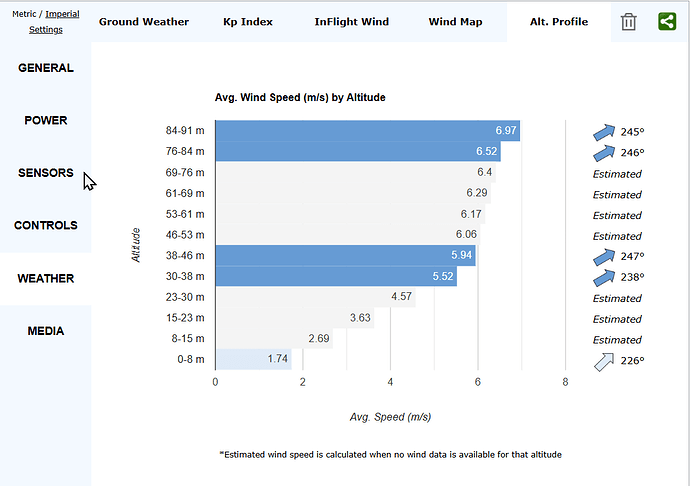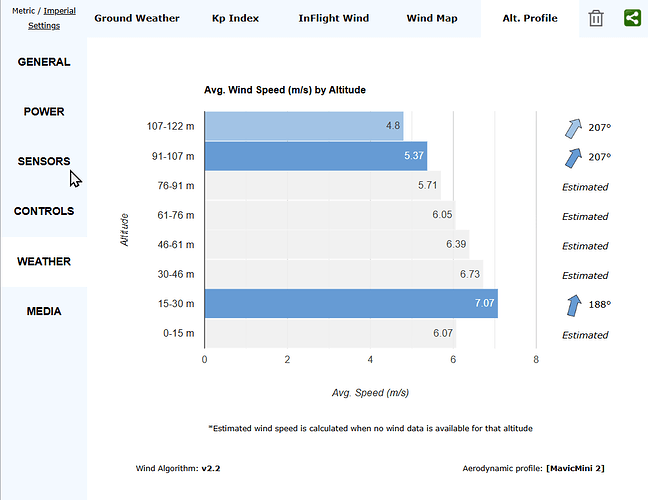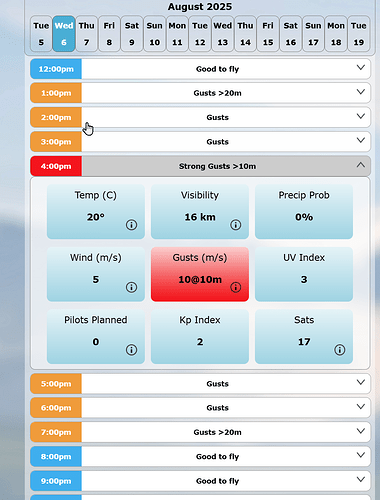So after owning my first drone now for 2 weeks, one of the main things I have come across is knowing when the wind, and gusts are safe to fly in, and worth flying in. I am using the UAV Forecast app and I am reading thats wind speeds of 23 mph are the max speeds to fly in. But gusts are something where I’m struggling. Today is a nice day and I wanted to go flying, and the wind speed is fine. Where the app is saying don’t fly is because of the gusts. What are your experiences and if you have any advice then that would be great.
Any weather app is not 100% accurate - use it as a guide - check out the spec’s of your drone to see what the max gust winds are ( the DJI Mini 4 pro is around 24mph ) and you will find that the wind speeds change at different hights - so it might be nice and calm at ground level but just crazy at 50m up.
I use apps like the Met office and UAV Forecast as a general idea and just keep an eye on how the drone is performing in cinie / normal mode so that I know if I need to get back to home I should be able to use the sports mode for the extra power for the fly back to my home point.
I would not stop it from flying me as such unless the gusts are way more than the drone can handle and the normal wind speeds are close to the max speeds.
Its just how confident you are at the time you launch I guess - but its only a guild from what the app is telling you. Real world may not be as bad as the app is saying as the data is not from your take off point but can be many miles away.
Absolutely…
The best weather indicator is yourself being on site when you intend to fly.
Yer I get you and thanks for the info, I did set the app at 50m for the altitude. I guess I just need to be a bit more confitdence as well or I will never fly with our UK weather.
it just takes time to get to know what your drone is capable off - if you go and check out DCRainmakers website he has wind tests for all sorts of drones and you will be shocked at how much they can take. Ages ago I went flying with a mate and recorded his drone at hight and it was bouncing all over the place but the video was supper smooth but the controller had warnings about wind - all was good
Use sport mode more for the power to get you out of trouble with head winds when returning and keep an eye on the battery levels and you will be fine - don’t push the limits to the max till you have a good idea what them max points will be and what your confident with.
Not too sure where I have read/heard this, but from memory windspeed at 400ft is approximately 1.5 x ground level. You will obviously need an anemometer to take the reading at ground level as a starting point. I have 3 drones and this simple calculation guides my decision to fly or not as all apps vary in their guesstimates. To date this has never let me down from the Neo to the Air3s. Hope this helps?
Thanks for the info, ill look into it.
The Windy app is good and you can set it for any altitude. Also try to fly into thevwind and then thecwind will help get the drone back when the battery goes down
Normally the wind speed is greater at height. But these are two wind/altitude profiles from a couple of recent flights.
Above is the classic profile, incxreasing with height until it’s FOUR times the ground speed around 90metres.
A flight a few days later however shows much the same speed at all heights. Unfortunately the wind speed data is only available after the flight ![]()
I use Airdata to log the flights. Many of us do as it is a mature website / app. It has a free service which allows you a good number of flights and then subscription modes - discounted to dsilver and gold GADC members.
Here is a typical set of data taken from a recent flight:
Airdata also has OKtoFly which is a forecast app tailored to drone flying. In the free service you are limited to three days I believe, paid it is fourteen. From experience it errs on the side of caution.
Whichever weather app(s) you use @briwy has the right idea. Fly out into the wind then you have the wind assisting you on the way back. If however you are struggling against a wind you can lower your altitude and it should be less forceful at the new height.
Depending on your drone you should be getting a warning when it is struggling - take heed, drop your height and come back home!
Thanks for the info, ill download it and give it a go. I did take the drone out in the end sbd to be fair it coped really well. It was a huge open space as well so there wasn’t too much cover. There is so much to learn but im enjoying it and hopefully it will get easier.
Try and get along to a local meetup @Tom1980 - we’ve got so many helpful members here who are more than happy to share their years of experience with new members ![]()
A local meet is a great confidence builder ![]()
Im off to one this Sunday in the west midlands so ill be a human sponge for the morning.
A useful general guide, Andymack1966; tx!
Absolutely this; my take is that the drone is smart, the RC is smart, the phone is smart, hell, even the batteries are intelligent, and the drone is up there and knows how strong the wind is. If the warning is for high wind, you will be told to lose altitude or land; I’ve generally found that dropping 50’ or so will allow you to fly without the warnings, but if the wind is strengthening, there may be further warnings, until you are at ground level anyway; time to pack up and head for the pub!
I find UAV Forecast to be very useful, as a lot of vital information is instantly visually displayed. You can alter the parameters in the settings, so if you do not set for higher wind speeds than your drone can handle (level 5, 24mph), you should be fine but keep an eye on it as you ascend. If the display image is not steady, it is definitely time to come down; DJI gimbals are awesome!
I’d agree with going to meetups if you can; it will increase your confidence considerably! In the meantime, practice as much as you can and get the ‘feel’ of it.
Thanks for the info, im hoping to get as much help this weekend at the west midlands meetup and like you said, just keep on flying and gaining experience.
I’ve had my Mini 4 Pro for a year and half now and I’m constantly amazed at how it can deal with high winds. I’ve grown in confidence in flying it in windy conditions. I’ve had a couple of close calls, one where I was out over water and it wasn’t going to make it back and I had to change course and make for the nearest land but it went into it’s forced landing mode near the waters edge. Until then I hadn’t realised once it gets within a couple of metres of the ground it will then hover, I guess until the battery finally dies and it will just drop that last couple of metres. But this gave me just enough time to sprint across a couple of hundred metres across a wet beach and get underneath to save it before the final ditching.
I’m telling you this story for one very good reason, I almost lost the drone on that occasion because I flew downwind in a very strong wind to start with. If you are going to fly in a strong wind then the absolute best thing you can do is always plan your mission to fly upwind first and that will give you the best chance of getting the drone back as the wind will be with you on the return home.
As well as checking the wind forecast I carry a small anemometer to check on site before launch. Amazon have a huge selection I have the TopTes TS 301 which fits neatly in with my drone gear.
Doesn’t mean I don’t push the limits but if the warning does come up then I lower the drone and bring it home. Had to do that on Sunday as I wanted to check out a landscape feature, managed one picture before I got a warning and landing was very tricky even though I took off and landed in the calmest bit I could find. If you are like me and wander off into the middle of nowhere to find thing then I strongly recommend a launch/landing pad, the round collapsible ones work best for me, keeps the drone off the vegetation and can be levelled to a certain extent using the fixing pegs.
I did take a look at these yesterday and they are not to expensive so I might just get one this week. So far in terms of battery I normally call the drone back earlier than I need to until I get used to returning home into a head wind.
I find the mini 4s want to RTH at 20% so around 20 mins flying time, the Mavic seems to go down to around 16% so averages out around 40 minutes flying time. I’ve only just got the Mavic so haven’t flown it in anger yet, next time out I’ll spend half a day in the hills and put it and myself through our paces.
Maybe it’s just me but why would you want to push your drone’s battery life to 20% remaining?
My rule of thumb is return with at least 35% left at a sensible distance.
At the moment I’m practicing my piloting so I tend to fly non-stop round about home fields to get the hours in developing skills and polishing moves. Some of the filming takes that long to cover the footage I want to get. I think the Mavic will give me sufficient time.


